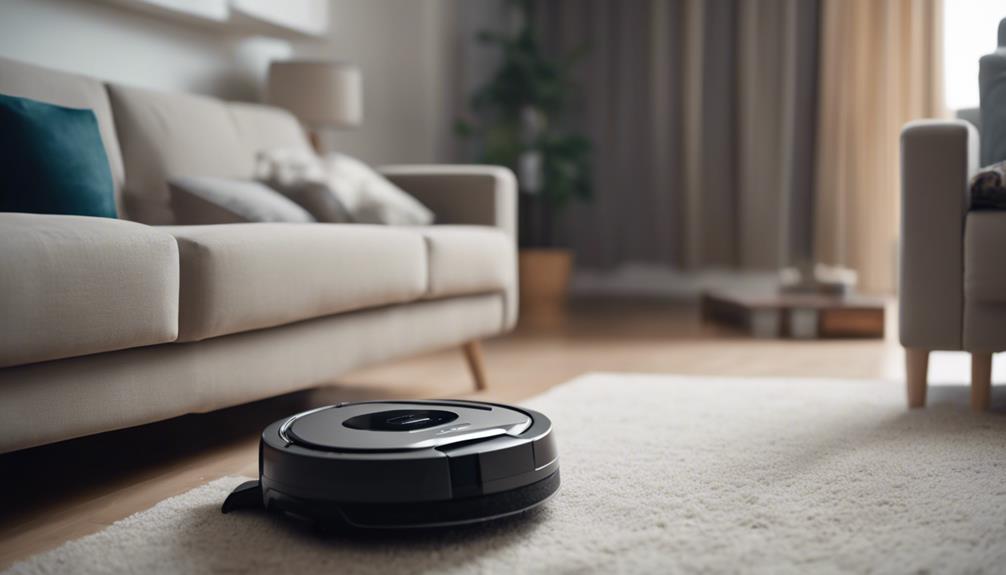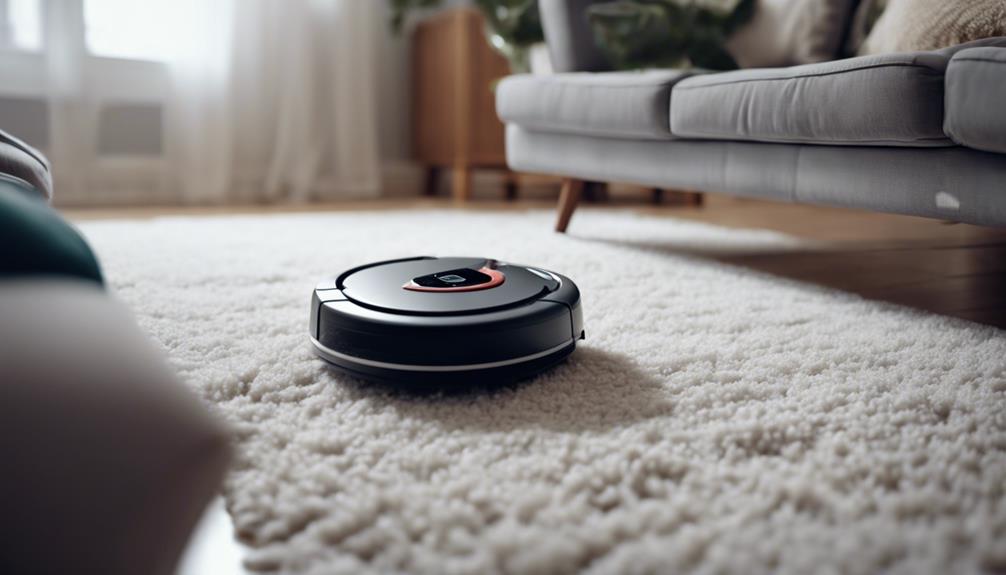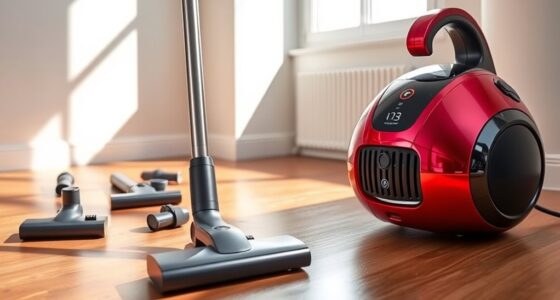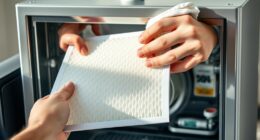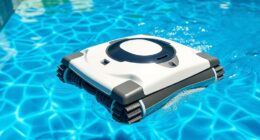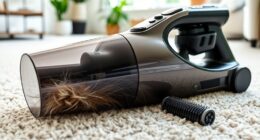Robot vacuum mapping uses sensors like LiDAR and cameras to create a detailed digital layout of your home, helping the vacuum navigate efficiently. It builds and updates maps in real-time, allowing it to plan routes and avoid obstacles. Different systems, like camera-based or laser-based, impact accuracy and performance. While challenges like reflective surfaces or clutter can limit mapping quality, proper setup and maintenance improve results. Keep exploring to discover how these technologies can work best for your space.
Key Takeaways
- Robot vacuums create detailed digital maps using sensors like LiDAR or cameras for precise navigation.
- Proper sensor calibration and environment setup are crucial for accurate mapping and obstacle detection.
- Mapping systems optimize cleaning routes, conserve battery, and ensure thorough coverage, reducing missed spots.
- Challenges include reflective surfaces, clutter, and poor lighting, which can impair map accuracy and sensor performance.
- Regular maintenance and a tidy environment enhance mapping reliability, while future AI advancements aim for smarter, more autonomous cleaning.
The Basics of Robot Vacuum Mapping Technology

Robot vacuum mapping technology enables your device to navigate your home efficiently by creating a digital map of the area. It relies on advanced mapping algorithms that process data collected by sensors to understand your space. Proper sensor calibration is crucial; it ensures the sensors accurately detect walls, furniture, and obstacles. When calibration is off, the robot might misinterpret its environment, leading to inefficient cleaning or missed spots. These mapping algorithms analyze sensor inputs to build a layout of your home, allowing the vacuum to plan ideal routes. The technology constantly updates the map as it cleans, adapting to changes like moved furniture or new obstacles. Additionally, sensor calibration ensures the accuracy of environmental detection, making your robot smarter and more effective at tackling your cleaning needs.
How Robot Vacuums Create and Use Maps

To create accurate maps, your vacuum uses sensors like LiDAR, cameras, and infrared to scan its surroundings. These sensors gather real-time data, which the vacuum’s onboard processing systems analyze using advanced mapping algorithms. Sensor integration allows the robot to combine inputs seamlessly, creating a detailed layout of your space. As your vacuum moves, it continuously updates its map, recognizing obstacles and room boundaries. This dynamic process helps it navigate efficiently, avoiding missed spots and obstacles. The map data is stored and used for optimized cleaning paths, ensuring thorough coverage. Additionally, the vacuum adapts to changes in the environment, like furniture movement, by updating its map on the fly. Understanding sensor calibration and maintenance can improve its accuracy and longevity. Overall, sensor integration and mapping algorithms work together to make your robot vacuum smarter and more effective.
Types of Mapping Systems and Their Differences

Different mapping systems use cameras or lasers to create your vacuum’s layout, each offering distinct advantages. Cameras can provide detailed images but may be less accurate in poor lighting, while lasers typically deliver more precise maps regardless of lighting conditions. Understanding these differences helps you choose the right system for your cleaning needs.
Camera vs. Laser
While both camera and laser systems aim to create accurate maps of your home, they achieve this in distinct ways. A robot camera relies on visual data captured through its lens, allowing it to recognize landmarks and navigate based on images. This method works well in well-lit environments but can struggle in low light or cluttered spaces. Laser navigation, on the other hand, uses a laser scanner to emit beams that map your home’s layout with high precision. It creates a detailed 3D model of your environment, enabling efficient and thorough cleaning. Laser systems are generally faster and more reliable in various lighting conditions. Additionally, automation in robotics technology like these is continually advancing to improve navigation and mapping capabilities. The choice between a robot camera and laser navigation impacts how your vacuum perceives and navigates your home, influencing overall performance.
Mapping Accuracy Levels
Mapping accuracy varies considerably depending on the system your robot vacuum uses. Some models offer high mapping precision, allowing for detailed and reliable floor plans, while others fall short of accuracy benchmarks. Laser-based systems typically provide better accuracy, creating precise maps that help avoid obstacles and optimize cleaning routes. Cameras, on the other hand, may struggle with lighting conditions, reducing their mapping correctness. The level of accuracy impacts how well your vacuum navigates and avoids missed spots or collisions. If you need thorough cleaning and efficient navigation, prioritize models with proven accuracy benchmarks. Understanding these differences helps you choose a system that best suits your home’s layout, ensuring your robot vacuum performs efficiently and maintains consistent cleaning results.
Benefits of Mapping for Efficient Cleaning
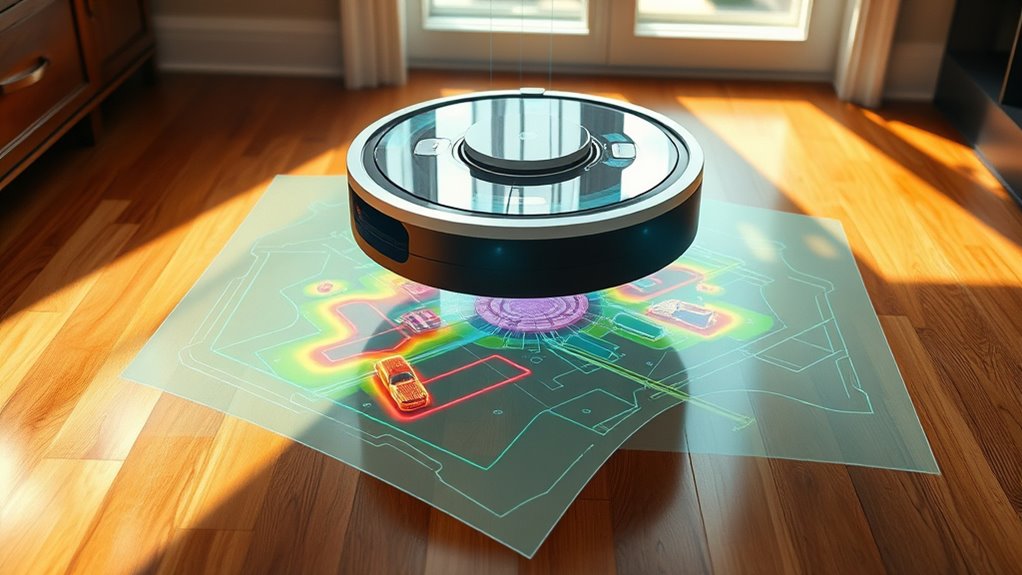
Mapping enables robot vacuums to plan their cleaning routes more effectively, guaranteeing every area gets covered without unnecessary overlap. This leads to significant mapping benefits, boosting cleaning efficiency and saving you time. With precise maps, your vacuum can focus on dirty spots and avoid missed areas, resulting in a more thorough clean. Additionally, mapping helps optimize battery use, allowing the robot to finish cleaning in fewer passes. Here’s a quick look at how mapping improves your experience:
| Benefit | Explanation | Result |
|---|---|---|
| Efficient route planning | Avoids repeated passes over same spots | Faster cleaning sessions |
| Area coverage | Ensures no zone is missed | Complete cleanliness |
| Battery optimization | Reduces unnecessary movements | Longer battery life |
A well-designed map also facilitates accurate navigation, ensuring your robot vacuum can adapt to changes in your home environment over time.
Common Challenges and Limitations in Mapping
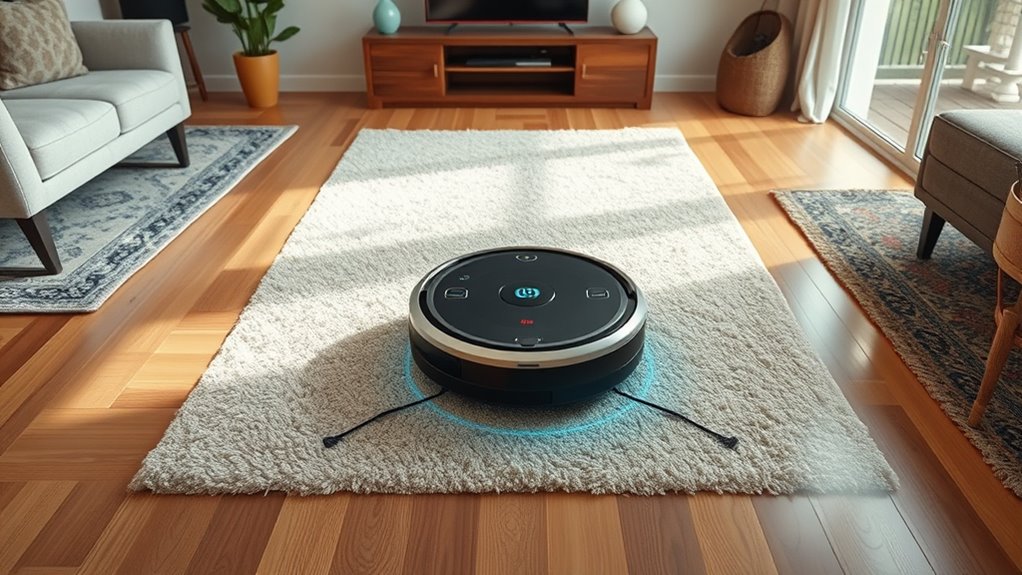
You might notice that robot vacuums sometimes struggle to detect obstacles clearly, which can cause missed spots or collisions. Limited mapping accuracy can also make it hard for the device to create a precise layout of your home. These challenges can hinder the overall efficiency of your robot’s cleaning performance. Inspirational quotes about fatherhood serve to remind us of the importance of guidance and support, much like the role of effective mapping in ensuring thorough cleaning.
Obstacle Detection Difficulties
Why do obstacle detection systems in robot vacuums often struggle to identify certain objects accurately? It’s mainly due to sensor limitations that hinder obstacle recognition. Some objects, like thin cords or transparent items, may not reflect sensor signals well, causing missed detections. Other times, sensors may get confused by shiny surfaces or dark carpets, leading to false positives or overlooked obstacles. Additionally, the effectiveness of these sensors can vary depending on the paint coating type or surface texture, which can further impact obstacle detection accuracy.
Imagine these objects as:
| Easy to Detect | Hard to Detect |
|---|---|
| Thick furniture legs | Transparent glassware |
| Brightly colored toys | Thin cords or wires |
| Raised rugs or mats | Dark carpets or reflective surfaces |
These limitations challenge your vacuum’s ability to navigate smoothly and avoid surprises.
Limited Mapping Accuracy
Despite advances in sensor technology, many robot vacuums still struggle to create accurate and complete maps of your home. Sensor limitations can hinder mapping precision, especially in complex layouts or cluttered spaces. For example, low-quality sensors may miss small obstacles or misjudge distances, resulting in gaps or errors in the map. Additionally, reflective surfaces, dark carpets, or transparent objects can confuse sensors and reduce map accuracy. These issues mean the vacuum might miss areas or double back unnecessarily, wasting time and energy. While newer models improve mapping capabilities, sensor limitations still pose challenges. To get the best results, make certain your home is well-lit, free of reflective surfaces, and avoid sudden obstacles during mapping. This helps your robot vacuum create a more accurate, reliable map of your space. Understanding sensor technology can also help you choose a model better suited to your home’s specific conditions.
Tips for Optimizing Your Robot Vacuum’s Mapping Performance
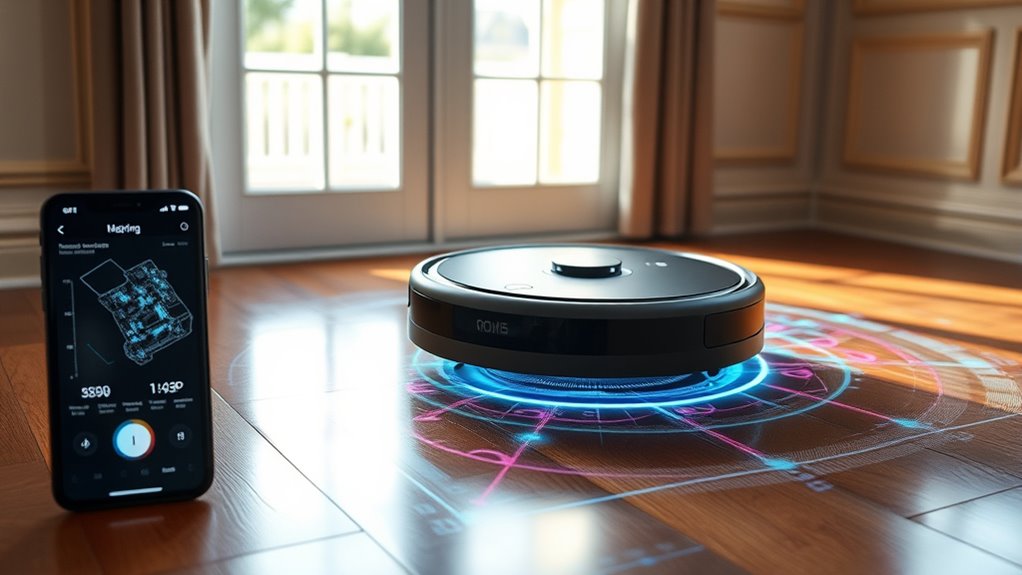
To get the most out of your robot vacuum’s mapping capabilities, optimizing its environment is essential. Ensure your floors are clutter-free to allow smooth navigation, which helps conserve battery life and improves mapping accuracy. Regularly clean sensors and brushes to prevent dust buildup that can cause errors. Adjust noise levels by scheduling cleaning during quieter times, minimizing disturbances that might interfere with the vacuum’s sensors. Keep an eye on battery health; a well-charged battery guarantees the vacuum completes full mapping cycles without interruptions. Use boundary markers or virtual walls to limit the vacuum’s reach in complex spaces, reducing confusion and optimizing performance. Monitoring for potential symptoms or issues can help you identify when maintenance is needed to keep your vacuum functioning optimally. These simple steps enhance your robot’s ability to map efficiently, saving time, extending battery life, and maintaining quieter operation.
Future Trends in Robot Vacuum Navigation Systems
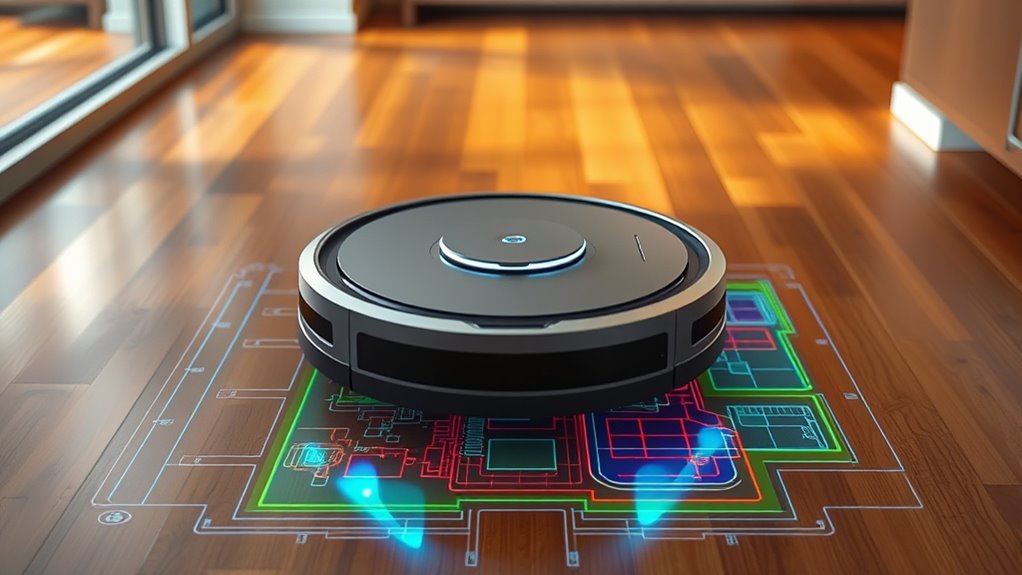
Advancements in robot vacuum navigation systems are poised to revolutionize home cleaning by making devices smarter, more efficient, and more adaptable. Future trends focus on enhanced autonomous navigation, allowing vacuums to independently map and adapt to changing environments in real time. AI integration plays a key role, enabling these devices to learn from their surroundings, recognize obstacles, and optimize cleaning paths more effectively. Expect to see improved obstacle avoidance, better room recognition, and smarter scheduling based on your habits. These innovations will reduce missed spots and minimize user intervention, making robot vacuums more reliable. As AI continues to advance, your device will become increasingly intuitive, providing seamless cleaning experiences tailored to your home’s unique layout. Additionally, ongoing research into artificial intelligence applications promises even greater adaptability, allowing vacuums to handle complex layouts and dynamic obstacles with minimal human input.
Frequently Asked Questions
How Secure Is My Privacy With Robot Vacuum Mapping Data?
Your privacy with robot vacuum mapping data depends on the brand and its data security measures. While many companies encrypt your data and restrict access, privacy concerns still exist if the information is shared or stored improperly. To safeguard yourself, review the privacy policies, keep firmware updated, and disable features you don’t need. Staying informed and cautious helps ensure your data stays secure and your privacy remains protected.
Can Robot Vacuums Recognize Multiple Users or Household Members?
Yes, many robot vacuums now recognize multiple users through multi-user recognition technology, making household personalization possible. You can customize cleaning schedules, preferences, and even targeted cleaning for different family members. This smart system tracks individual movements, ensuring each person’s needs are met efficiently. With multi-user recognition, your robot vacuum adapts seamlessly to your household, providing personalized, precise cleaning while respecting everyone’s space and routines.
What Maintenance Is Required for Maintaining Mapping Accuracy?
To keep your robot vacuum’s mapping accurate, you need to regularly perform software calibration and sensor cleaning. Calibrate the software as recommended by the manufacturer, often after updates or changes in your home. Clean the sensors with a soft cloth to remove dust and debris, ensuring they can detect obstacles and walls properly. These simple maintenance steps help your vacuum navigate efficiently and maintain peak mapping over time.
Do Mapping Features Work Equally Well on All Floor Types?
Think of your robot vacuum’s mapping like a painter with a delicate brush—it’s great on smooth, open canvases but struggles with textured or dark surfaces. Floor type compatibility varies; carpets, hardwood, and tiles each pose unique challenges. Sensor limitations mean it might miss corners or get confused on reflective or uneven surfaces. So, no, mapping features don’t work equally well across all floor types, especially where sensors face obstacles.
Are There Any Health Concerns Related to Robot Vacuum Sensors?
You might worry about health concerns related to robot vacuum sensors, but generally, they’re safe. However, sensor interference can occur if you have devices like Wi-Fi or Bluetooth that disrupt sensor signals. Some people with allergies might experience reactions if dust or allergens are stirred up, but sensors themselves don’t cause allergic reactions. To stay safe, keep sensors clean and ensure your environment minimizes potential interference.
Conclusion
Now that you understand how robot vacuums map your home, aren’t you eager to maximize their efficiency? By choosing the right system and following some simple tips, you can guarantee thorough cleaning and fewer issues. Remember, technology keeps evolving—so isn’t it time you let your robot vacuum do the hard work while you enjoy a cleaner space? Take control of your cleaning routine and experience the difference today.


